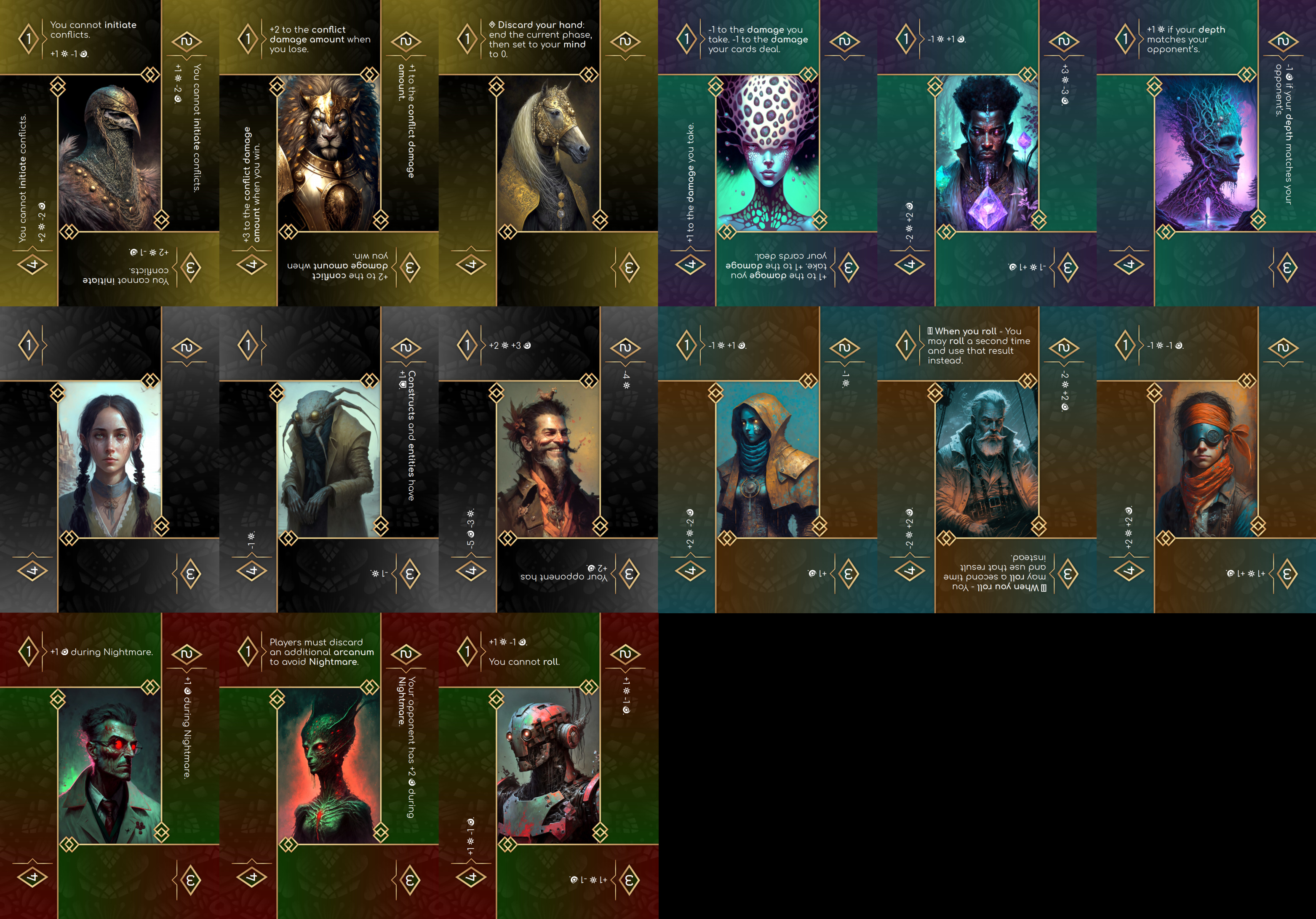1 - Introduction
The eternal balance of Dream and Nightmare has been disrupted by a third element, Void.
A violent, crimson cacophony takes root at the center of the realm, and with it it brings a strange stability. As their waking lives fade away into a blur, Dreamers find themselves coming back to the same locations—loci of power known as bastions—and interacting with the same entities every night. Soon they recognize each other, share memories, thoughts, fears, and understanding over their newfound abilities.
With this new structure comes hierarchy, and with hierarchy comes unrest, disagreement and conflict. Four emerging powers struggle for control of the Dream:
- The Chimeric Court seeks to establish law and order, steeling the realm against the unknown threat and upholding the barrier that separates Dream and Waking.
- Fracta, a manifold extension of crystal jungles and pristine lakes, housing those who turn their back on the Waking and seek the secret of eternal sleep.
- Subter Venellam, experts of time and motion who move unburdened between the layers of the mind, managing the Dream's infinite transport network.
- The Maze, a collective of researchers that accept the burden of containing and studying the Void. Their sanity suffers, but their knowledge of the realm is unparalleled.
In Voidream, you take the role of a powerful Dreamer in the midst of a conflict among four factions. You must leverage ingenuity and willpower to shape the Dream, commanding its creations to destroy your opponent's bastion.
However, you should be careful. In the pursuit of conquering your rival's bastion, exhausting your mind leaves you at risk of beckoning Nightmare, becoming forever lost to insanity.
Reading this manual
Throughout this manual, all important concepts and keywords will be shown in bold when first introduced.
Sections 1 to 5 contain all necessary knowledge to play a game of Voidream. Sections 6, 7 and 8 are optional and explore keywords, advanced topics and deckbuilding in depth.
2 - Components
Voidream is a two player competitive deckbuilding game. In the constructed play format, each player must bring their own deck, consisting of the following cards:
- 39 Dream cards, with numbered backs.
- 1 double sided bastion.
- 8 arcana.
- 1 double sided mind card.
Some bastions may allow the player to tweak the proportions above (see the deckbuilding section for details), but the vast majority of Voidream decks use the numbers above.
Voidream is played exclusively with cards. No tokens, dice, coins or dials are necessary. This section introduces Voidream's different card types, so you can familiarize yourself with their looks and roles before covering the rules of play.
Arcana
Arcana are the most important card in Voidream. Arcana represent lucid, conscious actions taken in the dream world. Whether it's talking to an entity, taking a leap of faith, or simply pushing back an intrusive thought, you'll need to use an arcanum.
Your hand is composed of eight different arcana, which are available to you from the start of the game. The most basic action in Voidream is to play an arcanum.
Arcana consist of:
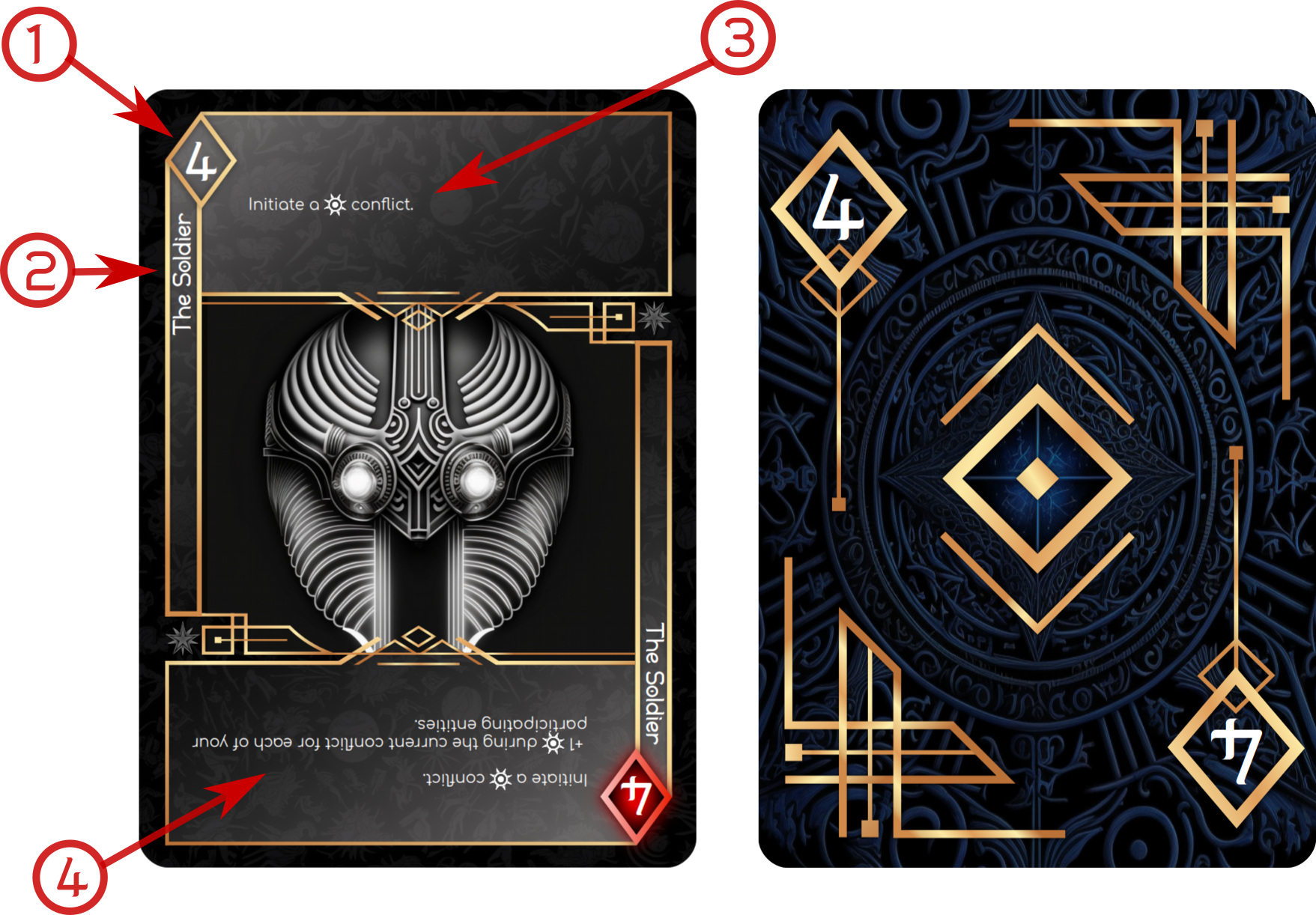
- (1) A numeric value, (top left), from 1 to 4. Higher values represent arcana closer to the waking, conscious mind. These are flexible and can be used frequently. Lower values represent arcana deeply rooted in the subconscious, with more powerful but more restricted effects. The value is also printed on the back of the card; this gives you a hint as to what tools your opponent has available at any time. Use this information carefully!
- (2) The card's title. Each of your eight arcana must have a different one.
- (3) The rules text (top). This shows what happens when the arcanum is played. Arcana resolve their effects immediately, and are sent to the arcana discard pile face up.
- (4) The inverted rules text (bottom). Dreamers may exert their energy to play a more powerful version of the arcanum, called an inverted arcanum. Not only the effect is more impactful; it also will return all discarded arcana to your hand! However, it comes at a cost: an arcanum that is played inverted is sent to the Void pile and lost forever.
If the rules text on an arcanum describes an ongoing effect (for example: "Your entities cannot be destroyed"), the effect applies until the end of the current phase, unless specified otherwise.
Strategy: As the game progresses, you will need to weave arcana and inverted arcana smartly to always have weapons at your disposal. You must however spend them judiciously: if you run out of cards too quickly, you will be at the mercy of Nightmare.
Dream Cards
While arcana are flexible, they're not too powerful. They're subtle tools which influence the Dream, wielded by the waking mind. The real force behind the dreamer's arsenal is found in the Dream deck, consisting of 39 dream cards and a double-sided bastion card.
Unlike other card games, there's no concept of drawing in Voidream. Instead, some actions allow you to evoke. In order to evoke, you must secretly look at the top card of the deck, then decide whether to play it or return it to the top.
Through evocation and other actions that affect the top of the deck, skilled players manipulate the Dream to their advantage. However, they're not doing this blindly: Dream cards have a value from 1 to 4, once again representing how close they are to the conscious mind, and this value is printed on the back of the cards. So, while it's not easy to know exactly what's coming, the number on the top of the deck (called the dream's depth) hints at what lurks on the surface of your mind.
Dream cards come in five different flavours: thoughts, memories, entities, constructs, and the all-important bastion.
Thoughts
Thoughts are the simplest form of Dream card. They are manifestations of the Dreamer's imagination, causing an immediate change on the world around them. Much like arcana, they perform their effect immediately, and are sent to the Dream discard pile face up.
Thought cards consist of:
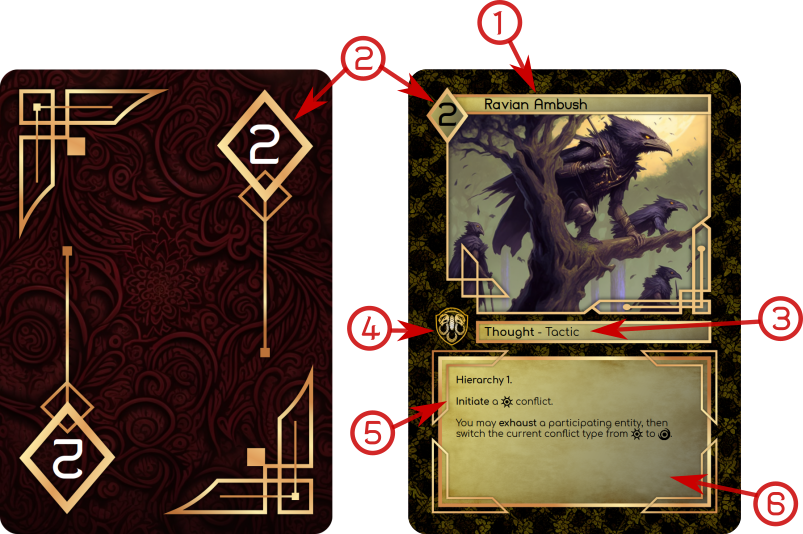
- (1) Their title at the top.
- (2) Their value (top left). As with all other kinds of Dream card, this matches the value printed on the back of the card.
- (3) The text "Thought" (center), identifying them as one, as well as an optional type that other cards may refer to.
- (4) The faction symbol (center left), identifying which of the Dream's factions it belongs to.
- (5) The rules text (bottom), showing what effects must be resolved when the card is played. They are read from top to bottom. Each separate effect line must be resolved fully or, in case its conditions can't be met, skipped.
- (6) Optional flavour text, expanding the narrative world of Voidream.
Just like arcana, if the rules text on a thought card describe an ongoing effect, it applies until the end of the current phase, unless specified otherwise.
Memories
Memories represent lingering fragments of the Dreamer's mind, imposing a lasting effect on the dream world.
Memories look very similar to thoughts, and have the same card elements. The difference is that memory card effects stay active indefinitely, or until the memory is destroyed by another card effect. Once played, a memory stays on the player's play area, where any text printed on it is permanently active.
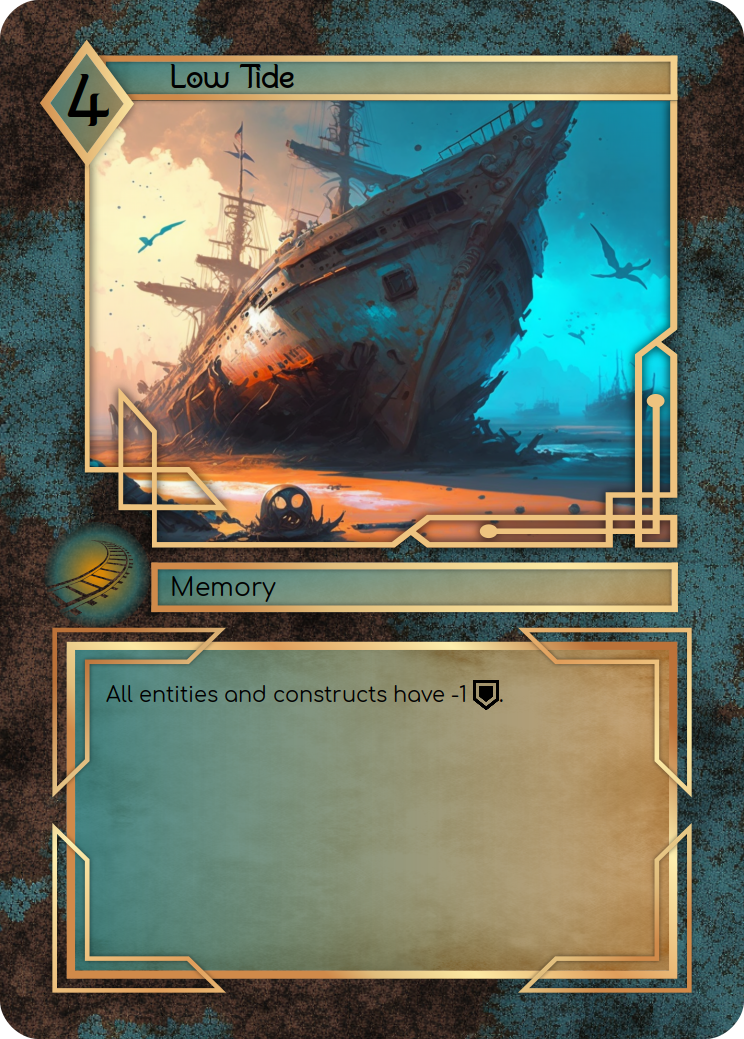
Memories, as well as other persistent Dream cards such as entities, can sometimes be exhausted (turned sideways) as an action, in order to cause an effect. In that case, they will ready at the start of the next round.
Some memories can be attached to other entities or memories. Attached memories move with the card they're attached to, and are discarded if their host card leaves play. A card that is attached cannot itself have attachments.
Entities
Entities are the denizens of the Dream, called to lend the player their aid. Whether they're other Dreamers, synthetics (imagined by the Dreamer themselves), or natives to the realm, entities possess their own intelligence and will.
Aside from the elements in common with thoughts and memories, entities have additional elements at the bottom of the card:

- (1) Their dawn value, representing their prowess in dawn conflicts. Generally, a higher number is better. Depending on the entity, this value may symbolize their physical might, glamour, their persuasion skills, and countless other abilities involving force and domination.
- (2) Their stability value, representing their ability to endure hardship and remain at the Dreamer's side. Generally, higher is better. Stability may symbolize the entity's resistance to harm, mental endurance, loyalty, structural integrity, and many others.
- (3) Their dusk value, showing their impact in dusk conflicts. Generally, a lower number is better. Dusk conflicts are encounters of cunning, subterfuge and betrayal where blades turn against the Dreamer. This value may represent the entity's treachery, selfishness, ability to lie, their tendency to adopt the twisted shape of Nightmare, as well as many other dark traits.
Like memories, entities remain on the play area once played, until they're sacrificed or destroyed, either by another card effect or by participating in a conflict.
Constructs
Constructs are large material structures conjured or recruited by the Dreamer. They significantly alter the tapestry of the dream world, offering the Dreamer protection and refuge. They take a tremendous amount of energy to maintain, so each Dreamer may only have a single construct active at any given time.
When you play a construct, it's immediately placed on top of your deck face up. This effectively blocks your ability to evoke, in exchange for sizeable defensive (and sometimes offensive) benefits. If an active construct moves deeper into the deck, it remains face up and may be uncovered later.
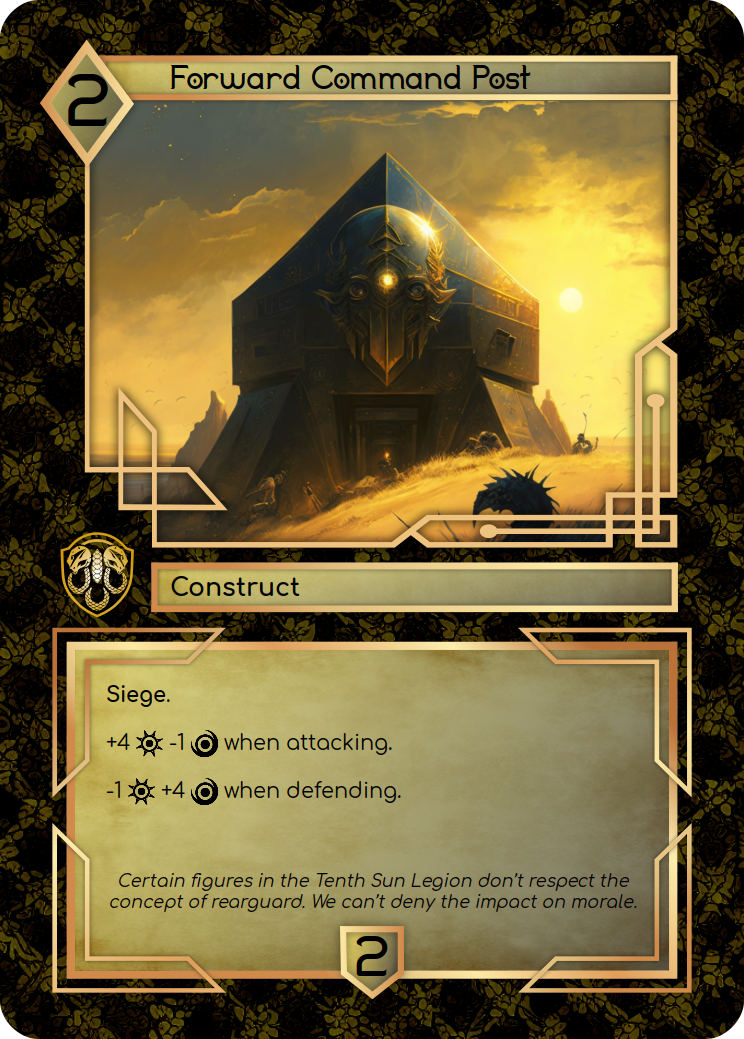
Like entities, constructs have a stability value, representing the difficulty of taking them down. Unlike entities, constructs cannot directly participate in conflicts, so they possess no dawn or dusk values.
The Bastion
The bastion is the Dreamer's ultimate fortress. It's a material location that serves as your source of power and maintains your lucid connection to the dream world. Whether it's an imposing building, a vehicle, or a drifting patch of land, if your bastion is destroyed you shall be exiled to the blurry, mindless sleep of the past, forced to roam the realm as bastionless.

The bastion card is a special kind of construct. In fact, it behaves as a construct for all purposes, with a few additions:
- After the deck is shuffled at the start of the game, the bastion card is placed at the bottom of the deck, face up. It is always active, and can never be flipped face down.
- At any point, if your Dream deck doesn't contain a bastion, your connection to the Dream is severed and you immediately lose the game.
- The bastion can only leave the deck if destroyed by damage. Any effects that would cause a bastion to be directly destroyed without dealing damage, flipped face down, or moved to a different game area will automatically fail.
- The back of the bastion card contains that bastion's deckbuilding rules (1), which details the limits and restrictions for building your deck. Some bastions have special effects that trigger at the beginning of the game, which are also detailed here. In the example above, this bastion requires a 40 card Dream deck (of which 8 cards may belong to a guest faction), and a hand consisting of The Dreamliner and another 7 arcana (of which 2 may belong to a guest faction). Read the section on deckbuilding for more details.
Stategy: To prevail against your opponent you must tear through the layers of their Dream until their bastion is exposed, then take it down with a decisive attack. Your own Dream cards are the main tool to achieve this, but beware: every card you remove from the deck means one fewer layer of protection on top of your own bastion.
The Mind Card
The last, and most complex card in Voidream is the single mind card, which begins the game in play. The mind card represents the Dreamer themselves, the driving emotion or trait that compels them to pursue their goals. It acts as a counter, keeping track of the amount of arcana you are able to play.
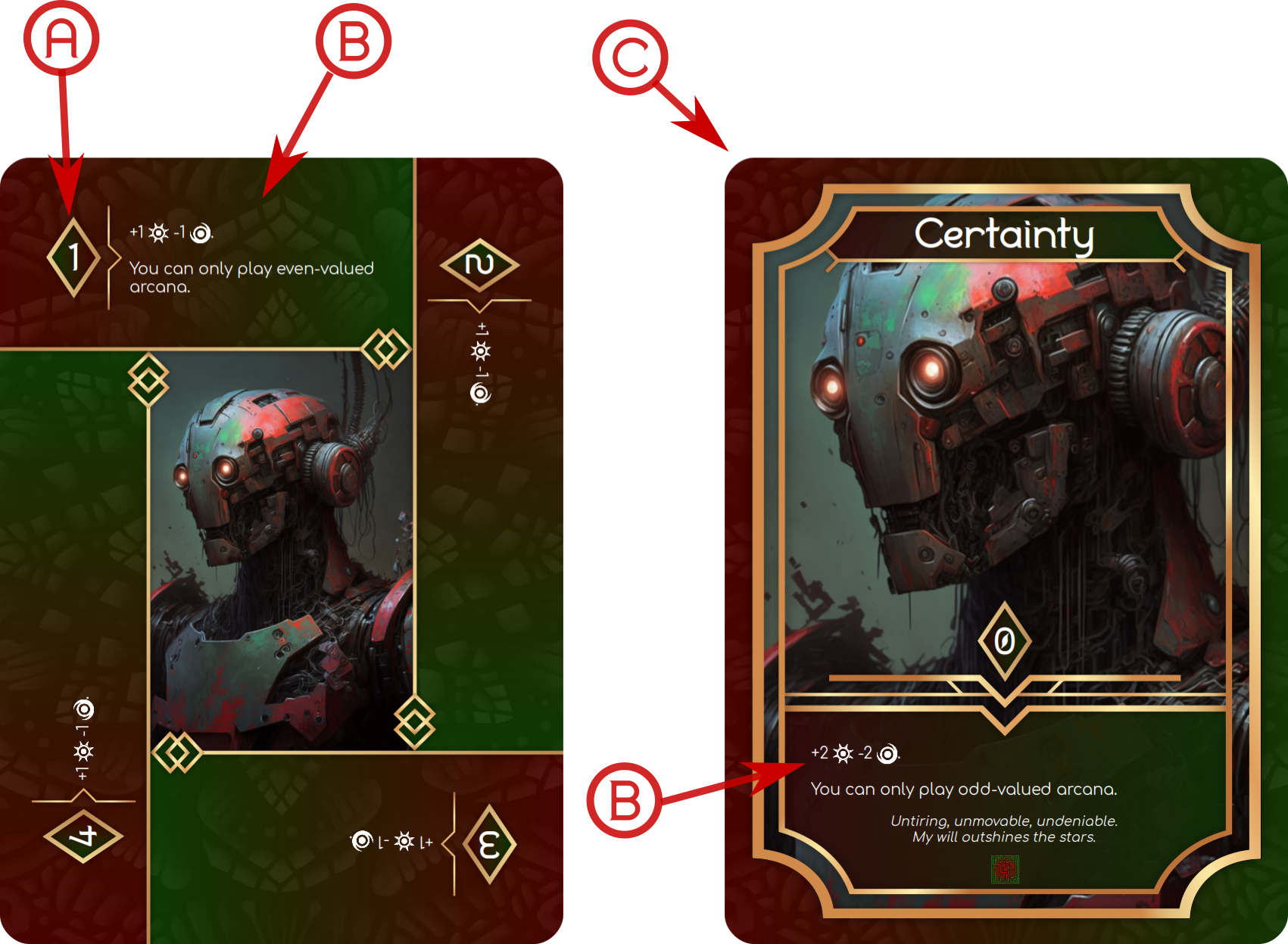
At the start of every round, you must rotate your mind card until the upright number (A) matches the depth of your Dream (the value on top of your deck). Then, as a cost to play arcana though the round, you must first turn your mind card, reducing the count by one. When you reach zero, flip the card to the spent side (C).
Mind cards aren't simple convenience reminders, though. As Dreamers navigate the hardship of conflict, their spirits rise and fall, their moods brighten and worsen. Any text in your mind card that is currently upright (B) is always active, so be sure to sequence your arcana correctly so you can ride the peaks and cross the valleys of emotion.

Example: The image above shows the progress of a typical round, where the Chimeric Court player begun with a card of value 2 on top of their deck. Since their depth is 2, they set the starting position of their mind card to 2, which already grants them a +1 dawn -2 dusk modifier. (Dawn and dusk will be explained in the conflict section).
As a cost to play the first arcanum of the round, they turn the card clockwise first. Since the text is immediately active, any arcanum they play right now would not be capable of initiating a conflict.
Later, they flip the card to the spent side to play the last arcanum of the round. Thanks to navigating the difficult requirements of the Cunning card, they're left with a powerful +2 dawn -2 dusk modifier for their final attack!
The Depth Rule
Now that you know about all card types in Voidream, we reach the most important rule about playing arcana; one that binds the arcana and Dream deck together:
The Depth Rule: In order to play an arcanum, that arcanum's value must be equal or higher than your current depth.
For example, if the top of the deck shows a 3, only arcana of value 3 and 4 can be played. Dreamers must be in the right mindset to tap deep into their well of creativity!
Strategy: High values in your Dream deck mean you will have access to more actions, as your mind card will copy the value on top of your deck at the start of each round. However, always having a high value on top of your deck severely limits the power and variety of arcana you have access to.
A skilled Dreamer rises and falls through the layers of the Dream to enjoy the best of both worlds, starting the round at a high depth to focus their conscious mind, then descending to the subconscious to unleash their true potential.
3 - Play area and setup
Below is the recommended layout for your side of the board during a game of Voidream. Feel free to tweak it in a way that's comfortable to you, as long as the layout is clear to your opponent and the same play areas are represented.
In particular, some decks care about the cards in the discard pile and Void. Since these are unordered piles, players are encouraged to arrange or split them in any way that makes sense to them, as long as it's clear to both players where the cards belong.

To set up for the game:
- Show your opponent your bastion and mind cards. Then resolve any "At the start of the game" instructions printed on the back of your bastion.
- Shuffle your dream deck, without the bastion card. Make sure to offer your opponent a cut, which must be performed.
- Place your bastion card under the deck, the side with the bastion name face up.
- Set up your mind card in its board position, and draw your hand of arcana.
4 - Rounds and phases
Voidream is played over a series of rounds, until one player is left bastionless or their mind is torn apart by Nightmare. Each round is divided in three mandatory phases:
- The beginning phase, where exhausted cards are readied, and the mind card is refreshed.
- The main phase, where players take turns playing one action each until both pass.
- The Nightmare phase, where one player must face the threat of Nightmare.
During the round, players may enter any number of conflict phases. When a conflict is resolved, the round will continue from the same point where the conflict was initiated.
Beginning phase
The beginning phase proceeds in the following steps:
- The active player is determined:
- For the first round of the game, the player at the highest depth (higher value on top of their deck) is the active player. In case of a tie, one player must secretly place their mind card face down on the table, covered. Their opponent must guess whether the numbered or the spent side is face up. If they guess right, they become the active player.
- For subsequent rounds, the player that faced Nightmare last round becomes the active player.
- Simultaneously, players ready (turn upright) any exhausted cards, and turn or flip their mind card until the upright number matches their depth.
- All "When the round begins" effects trigger.
Main phase
The main phase consists of alternating turns, starting with the active player. During your turn, you may perform one of the following actions:
- Activate an activated ability printed on any of your cards (marked with the diamond "A" symbol), provided you can pay the costs and resolve the entire effect line.
- Reduce your mind card by 1 to play an arcanum, of value equal or higher than your depth. Note that turning the mind card happens before playing the arcanum, and any text on the mind card that turns upright becomes effective immediately.
- Reduce your mind card by 1 to play an inverted arcanum, of value equal or higher than your depth. After the empowered effect resolves, you return all previously discarded arcana to your hand, then send the arcanum you played to the Void pile, where it's lost forever.
- Reduce your mind card by 1 to unveil face down cards, discarding one arcanum per card. (Some card effects allow you to place cards face down, veiled. You can take an action to play any number of them at once, discarding one arcanum for each card you flip face up.)
- Pass the turn.
Whatever option you choose, other cards in play may cause triggered abilities (marked with the exclamation mark symbol) to fire. If multiple of those abilities trigger simultaneously, you (as the active player) choose the order in which they resolve.
Once your chosen action has ended, and all triggered abilities as a consequence of it have resolved fully, your turn ends and your opponent becomes the active player. The main phase continues in this way until both players pass consecutively. When both players pass during the main phase, play proceeds to the Nightmare phase.
Nightmare phase
The rippling effects of the Dreamer's power draw the attention of Nightmare. In the Nightmare phase, the Dreamer showing least control over their mental and emotional state must face the threat of insanity.
First, the player who must face Nightmare is chosen:
- If there's only one player with an empty hand, that player is chosen to face Nightmare.
- Otherwise, the player with the highest value in their mind card is chosen to face Nightmare.
- In case of a tie, the last player to pass is chosen to face Nightmare.
Then, the chosen player proceeds to face Nightmare, by avoiding or entering it:
- The chosen player may discard an arcanum from their hand. If they do, Nightmare is avoided, and the next step is skipped.
- If the chosen player can't discard a card, or decides not to discard one, they enter Nightmare.
- After Nightmare is fully resolved, "When the round ends" effects trigger.
Entering Nightmare
When dreams have the ability to shape a world, Nightmare is the Dreamer's biggest fear. Entering Nightmare may have catastrophic consequences on their mind and surroundings. No sane Dreamer would voluntarily enter Nightmare... Then again, sanity is not a requirement for greatness.
When you enter Nightmare, you must follow these steps:
- Return all discarded arcana to your hand, as your mind hastily wrestles for control.
- Move one arcanum from your hand to the Void. If you can't, your mind is torn apart by insanity and you immediately lose the game.
- Initiate a dusk conflict (which will be explained later), declaring every ready entity you control as an attacker. During this conflict, you're considered in Nightmare, which other card effects may reference.
When the Nightmare dusk conflict resolves, play continues to the start of next round. Whether you avoided Nightmare by discarding a card, or chose to enter it, you become the next active player.
Conflict Phase
The struggle for control over the Dream is represented by Voidream's two kinds of encounter; dawn and dusk conflicts, represented by sun and moon symbols respectively.
- Dawn conflicts are honest, noble and fierce. From a coordinated attack by the Court's mobile assault forces to a contest of wits between two Maze researchers, the dawn conflict pits Dreamers and entities in direct opposition, putting the extent of their forces on display.
- Dusk conflicts, in contrast, are treacherous and sinister. Poisonous words whispered by an advisor, an ambush in the dark or a betrayal by a close friend could be represented by a dusk conflict. You should not face dusk conflicts alone, but you'd do well in choosing your allies carefully.
Conflicts can be entered from any of Voidream's other three phases. If a card effect calls for a conflict to be initiated, the current phase ends immediately and play transitions to a conflict phase. When the conflict ends, play returns to the phase it initiated on.
Note: If a card ability calls for a conflict to start while a conflict is already taking place, it has no effect.
Dawn and dusk conflicts proceed in an identical way until the end, where they differ on the way they resolve. The following steps are common to both kinds of conflict:
Conflict Phase Common Steps
- The attacking player (the player who is initiating the conflict) declares any number of ready entities as attackers. Those entities are pushed forward in the playing area to that player's conflict area. Note that it's not necessary to control any entities to initiate a conflict; the Dreamer is capable of fighting alone.
- The attacking player chooses dawn or dusk, if the effect that initiated the conflict does not specify one.
- The defending player chooses any number of ready entities as defenders. These entities are pushed forward to that player's conflict area.
- At this point, the conflict is considered initiated, and any effects that trigger when a conflict is initiated do so now.
- Players take turns playing actions, among the same four actions available during the main phase, until both players pass consecutively.
Note that entering a conflict doesn't disrupt the turn order. You have access to the same usual actions, though some card effects are be restricted to be played inside or outside conflicts.
If an entity enters play during a conflict, it does so outside of the conflict, unable to participate. An exception to this is unveiling entities (flipping them face up): when an entity is unveiled it may join an ongoing conflict immediately, as if it had been declared attacker or defender.
Resolving Dawn Conflicts
When both players pass consecutively during a dawn conflict, the conflict is resolved following these steps:
- The attacking player rolls (moves the top card of their deck to the bottom).
- Each side's total dawn score is calculated. The dawn score is the sum of:
- The player's depth (value at the top of their deck).
- The dawn value of each of their ready participating entities.
- Any positive or negative dawn modifiers provided by other card effects.
- The side with the higher dawn score is declared the winner. In case of a tie, the conflict is considered a draw.
- The winner deals an amount of damage equal to the difference in scores. The way this damage is distributed among entities is decided by the winner (read the section on damage for details.)
- All participating entities are exhausted, and the conflict ends. Play continues in the previous phase, preserving turn order as usual (the first player who passed is now the active player.)
Resolving Dusk Conflicts
When both players pass consecutively during a dusk conflict, the conflict is resolved following these steps:
- The attacking player rolls (moves the top card of their deck to the bottom).
- Each side's total dusk score is calculated. The dusk score is the sum of:
- The player's depth (value at the top of their deck).
- The dusk value of each of their exhausted participating entities.
- Any positive or negative dusk modifiers provided by other card effects.
- The side with the lower dusk score is declared the winner. In case of a tie, the conflict is considered a draw.
- The winner deals an amount of damage equal to the difference in scores. The way this damage is distributed is decided by the loser (read the section on damage for details.)
- All participating entities are exhausted, and the conflict ends. Play continues in the previous phase, preserving turn order as usual (the first player who passed is now the active player.)
To summarize the three differences in how dawn and dusk conflicts are resolved:
- In dawn conflicts, ready entities contribute to the score, where in dusk conflicts, exhausted entities do.
- In dawn conflicts, the highest score wins. In dusk conflicts, the lowest score wins.
- In dawn conflicts, the winner distributes the damage among the loser's entities. In dusk conflicts, it's the loser who decides how they take damage, distributing it among their own entities.
These three differences have far reaching consequences on how conflicts must be approached. Dawn conflicts benefit from a keen, awake mind at high depth (represented by a high value on top of the deck), while dusk conflicts draw from the twisted creativity of the subconscious. Dawn conflicts benefit from bringing many entities to contribute, but their violent nature puts everyone at risk as it is the winner decides who suffers the brunt of the damage. In contrast, dusk conflicts are best faced with a trusted crew that will not turn against the Dreamer, so they can share the pain.
Dealing Damage
Whether it's ego, flesh or stone, the price of conflict must be paid. The winning Dreamer will deal to the loser an amount of damage equal to the difference in conflict scores. However, depending on the type of conflict, either side will have the chance to choose exactly how that damage is allocated.
- In dawn conflicts, the winner chooses how the loser takes damage.
- In dusk conflicts, the loser chooses how they take damage.
Regardless of who makes the call, allocating damage must follow these rules:
- Damage must first be distributed among the loser's participating entities. An entity may take damage up to its stability value, and not more.
- If an entity takes damage equal to its stability, it is destroyed and sent to the loser's Dream discard pile.
- If an entity takes damage lower than its stability, the damage has no effect. Damage does not carry over between turns.
- After there are no remaining entities, and only if the attacker won, all damage remaining becomes Dream damage and it's dealt to the defender's Dream deck. If the defender won, skip the next two steps.
- If the defender has an active construct on top of their deck, it takes Dream damage up to its stability. If it takes damage equal to its stability, it is destroyed and sent to the Dream discard pile.
- If the defender does not have an active construct, they discard a card from the top of their deck for each point of Dream damage, until all damage is dealt. If this process uncovers an active construct, proceed to the previous step.
Some cards in Voidream will allow you to deal damage directly, even outside of conflicts. These effects will always specify whether the damage is dealt to an entity, or whether it's Dream damage, dealt directly to the opponent's deck or any constructs protecting it. Damage only accumulates during a turn, so it is possible for multiple triggered effects to combine and deal enough damage to take down a powerful entity or construct. However, as soon as the active player changes, all damage is cleared.
If an entity or construct has its stability value reduced to 0, it is immediately destroyed.
5 - Ending The Game
As we covered in the earlier cards section, the bastion card behaves as a construct that is always active. If a Dreamer's bastion takes damage equal to its stability, whether during a conflict or as a result of direct dream damage, it is destroyed. If this causes the deck to have no bastion (which is certain outside of rare cirumstances) that player loses the game.
This victory condition exists in a balance with Voidream's threat of surrendering to Nightmare. While arcana and Dream cards are both instrumental to success, playing too many of either weakens you against each peril. Keep both in mind as you structure a deck and strategy that will carry you to victory.
You now have all the tools needed to play a full game of Voidream! The next section is an optional glossary of terms and keywords. While it's not necessary to read it end to end, it's a good idea to have it in reach as you play your first games. After that, there is a FAQ covering several advanced rules and nuanced interpretations, so check that out if you find yourself in trouble. Finally there is a section on deckbuilding that describes all that's necessary to put together your own Voidream deck.
6 - Glossary
- Activated Ability: Marked with the diamond (A) symbol. Described as "(A)<cost>: <effect>" You must pay the cost and be able to resolve the effect in order to use an activated ability.
- Attach (verb): Place a card under another (known as the host card). When the host card leaves play or is veiled, face up attachments are discarded and face down attachments return to the bottom of the deck in any order.
- Charge (verb): Attach the topmost non-construct card of your deck, face down. The attached card is called a charge.
- Charge (noun): A face down card attached to a host. When the host leaves play, charges return to the bottom of their owner's deck in random order. You may look at charges you control at any time.
- Deep (keyword): Cannot be affected, damaged or targeted by cards of higher value. Conflict damage is not dealt by cards directly, so it's unaffected by deep. Preexisting attachments continue to work as normal if the entity gains deep.
- Depth: The value at the top of a player's Dream deck.
- Dormant (X) (keyword): Cannot be played or unveiled unless you have X or more arcana in your Void pile.
- Dread (entity keyword): When ready, add this entity's dusk value to your opponent's count.
- Evoke (verb, keyword): Look at the top card of your Dream deck. You may choose to play that card, if able. If you choose not to play it, return it to the top of your deck.
- Exhaust (verb, keyword): Turn a card 90 degrees clockwise. Exhausted cards may not be declared as attackers or defenders. and may not exhaust again until they're readied.
- Glaring (keyword): To unveil this card, you must discard an additional arcanum.
- Heroic (entity keyword): When assigning conflict damage, this entity must be assigned damage before entities without heroic.
- Hierarchy (X) (keyword): You must exhaust X entities as an additional cost to play or unveil this card.
- Indestructible (keyword): Cannot be destroyed, either directly or through damage. Can be voided normally.
- Inspire (verb, keyword): Activate all "When inspired" trigger abilities printed on a card.
- Loop (thought keyword): When played, move this card to the bottom of the deck.
- Prototype (X) (keyword): When this card is played or unveiled, it's sent to the Void instead unless there are X or more copies of it in your Void area.
- Shadowborne (X) (keyword): You must return X veiled cards to the bottom of your deck in any order as an additional cost to play or unveil this card.
- Siege (keyword): When you have siege, you may skip the roll at the end of a conflict.
- Subtle (keyword): To unveil this card, you must discard one fewer arcanum.
- Ready (verb): Turn an exhausted card upright.
- Roll (verb, keyword): Move the top card of your Dream deck to the bottom. The card revealed is the rolled card. The result of the roll, if it matters, is the value of the revealed card.
- Triggered Ability: Marked with the exclamation mark symbol. Described as "(!) <trigger condition> - <effect>". All triggered abilities are mandatory, and must resolve when the trigger condition occurs. In case of simultaneous triggered abilities, the active player chooses the order. Some abilities can trigger from unusual board positions like the discard or Void, so make sure to read the conditions carefully.
- Unique (entity keyword): If a Unique entity enters play while you control a card with the same name, it enters play attached to the preexisting copy. When its host entity would be discarded, you may discard the attached copy instead.
- Unveil (verb, action): Action that is always available when you control at least one veiled card. To unveil, reduce your mind by 1, then flip any number of veiled card you control face up, discarding one arcanum for each card unveiled. Unveiling a card counts as playing it .
- Void (verb, keyword): Move a card to the Void area.
- Void (noun, game area): The Void area contains all voided cards (Dream cards and arcana).
- Veil (verb, keyword): Place a card face down as a veiled card (a special type that is neither an arcanum nor a Dream card). Whenever you have veiled cards, you may take an action to Unveil.
- Voidbound (keyword): When discarded from play, this card is sent to the Void instead.
- Worship X (keyword): You must have X offerings in your Void to play or unveil this card. Offering is a card subtype.
7 - Advanced / FAQ
What happens if the rules text of a card contradicts the base game rules?
The card rules take precedence.
When do ongoing effects from end, for thoughts and arcana?
Unless the card specifies otherwise, all ongoing effects printed on a thought, an arcanum, an activated or a triggered ability stop being active at the end of the phase.
Note that when entering a conflict, the current phase doesn't end; it's instead paused to be resumed when the conflict resolves. This means that if an ongoing effect (for example, "+1 dawn to all entities") starts in the main phase and play proceeds to a conflict phase, the effect will continue until the end of the conflict.
When shuffling, can I simply stop when I like the value on top of the deck?
Shuffling is rare in Voidream, but it sometimes happens. Whenever you shuffle, you must offer your opponent a cut. This ensures that the shuffling player can't decide what value ends on top of the deck.
The cut can be refused, and deciding to do so can be an important decision, especially when Bastions and constructs are involved. The exception to this is the cut at the beginning of the game (during setup) which must always be performed.
Does the order of discard piles matter? Can I inspect them?
The Dream discard pile, arcana discard pile and Void pile are all face up and considered unordered. No card effects will refer to or rely on the order in which cards are moved to those piles. All three piles are considered public information and can be inspected by either player at any time.
I evoke a card with veil. Does this count as playing it? What about when I unveil it?
When you evoke a card with veil, you place it face down (without revealing it) directly. Veiling substitutes playing, so the card doesn't count as having been played. Thus, you evoked the card to veil it.
On the other hand, unveiling does count as playing the card, and is subject to all normal playing restrictions. For example, a card with dormant 2 would require you to have 2 voided arcana in order to unveil it.
Are veiled cards in play? Do they count as entering play when unveiled?
Veiled cards are considered in play, but they have no type; they're not even considered Dream cards. They are considered a separate game element called veiled cards, and can only be affected by effects that mention veiled cards or face down cards directly.
When a card is unveiled, it is considered to leave play and reenter play as it's flipped face up. This means that effects that trigger when a veiled card leaves play, or when a card enters play, would trigger normally as a consequence of unveiling.
Can I look at face down cards in play?
You may inspect face down cards in play under your control at any time. This includes veiled cards and charges. You may not look at face down cards controlled by your opponent, unless a card effect allows you to do so.
If an opponent looks at your face down card thanks to an effect, it is your responsibility to remember what card they looked at (for example by keeping it in the same area of the board) so you can accurately point them to the same card again. You must not shuffle or otherwise obscure face down cards after your opponent has inspected them.
Do card effects need to be resolved fully, top to bottom? What happens when I can't do something?
Cards are composed of effect lines. Each effect line is independent and must be resolved separately. It is possible that a card effect composed of multiple effect lines will only resolve partially. In that case, skip any effect lines that can't be resolved and play the rest normally.
For example, the Thought card "Nightflock Ambush" reads:
Initiate a dawn conflict.
You may exhaust a participating entity, then switch the current conflict type from dawn to dusk.
It is possible to play this card during a conflict. In that case, the first effect line would have no effect (as there's already an ongoing conflict), but the second line would resolve normally.
For an effect to be able to resolve, it must cause some change in game state. For example, an effect that reads "Exhaust all entities" would fail to exhaust any entities that are already exhausted. As long as there is a single entity that can be exhausted, the effect causes a change in game state and thus is capable of resolving.
An activated effect that would cause no change in game state other than the payment of its cost can not be activated. This includes actions whose first effect cannot be performed.
What happens if a card effect becomes impossible halfway through?
It is possible that as a card effect develops, circumstances change so that it can't continue to resolve. In that case, resolve the effect as far as possible, then abort the rest as soon as a condition becomes impossible to fulfill.
For example, a card effect that reads Deal 1 damage to an entity, then deal 1 damage to it again would not be possible to resolve fully against an entity with 1 stability.
Reminder: activated abilities that cause no change in game state other than the payment of their cost (for example because their first effect is impossible to resolve) can not be activated.
What is the point of cards like "Nightflock Ambush"? Why not directly declare a dusk conflict?
For reference, Nightflock Ambush reads:
Initiate a dawn conflict.
You may exhaust a participating entity, then switch the current conflict type from dawn to dusk.
Initiating a conflict refers to all steps until actions can be played, which includes:
- Declaring attackers.
- Choosing conflict type (when applicable).
- Declaring defenders.
In this particular case, the value of Nightflock Ambush is to choose whether to switch the conflict type after defenders have been declared. It's also worth noting that cards like this can be played even within a current conflict, in which case the first effect line would be skipped.
When exactly do triggered abilites happen? Do they interrupt an ongoing effect?
Triggered abilities (those marked with the exclamation point symbol) have a triggering condition that starts with one of three possible words: Before, When or After.
- Before triggers happen immediately before the condition or, when the condition is part of a card effect, before the entire effect line containing the condition. These usually precede entire actions, so they normally have no timing complications (e.g. "Before you play an arcanum...").
- When triggers happen immediately, even in the middle of an effect line. When triggers are usually substitution effects that directly modify what's occurring (e.g. "When you take Dream damage, prevent 1 damage"). Players must ensure to resolve the trigger as soon as possible, and any timing ambiguities are resolved by the active player.
- After triggers happen after the condition or, when the condition is part of a card effect, after the entire effect line containing the condition. For example, a trigger that reads "After you take Dream damage...", triggered by the effect line "Take 1 Dream damage, then evoke" would occur after the evoke, as the effect line must resolve fully before the trigger occurs.
When lifting cards from the top of the deck to reveal or look at them, what about the new card on top?
The back of the card on top of the deck (or the front, if it's an active construct) is always public knowledge. This means that whenever you play an effect that allows you to look at or reveal the top N cards of your deck, you must also consider that the back of next card in line will be shown to everybody.
When looking at cards from the top of my deck privately, do I need to show the card backs to my opponent?
Cardbacks in voidream are designed so they can be comfortably fanned (in a right handed fan) without exposing the backs to your opponent. When looking at the top cards of your deck, you must be careful to pick them up in such a way their back numbers are not shown, but must show the backs to your opponent in case there are any active constructs to see.
To be specific, the process to privately look at N cards from the top of the deck is as follows:
- Carefully fan the cards out so they can be picked up without exposing the back values. This may expose face-up active constructs, which your opponent is entitled to know.
- Pick up the fanned cards and inspect the fronts
I voided a card as an offering. How can I distinguish it from other cards that went to the void for a different reason?
The Void is not a single pile, but an entire area outside the game where you may arrange the cards freely. Keeping the offerings in a separate pile in the Void is a good way to keep track of them.
Can I attach a memory to another attached memory? And to a veiled card?
Cards that are attached to a host cannot themselves have attachments. If an effect would instruct you to attach a card to a memory, and that memory is already an attachment, the effect fails to resolve.
In general, only entities and unattached memories can be hosts. Neither constructs, nor veiled cards, nor charges can have their own attachments.
What happens if a sequence of actions or triggered card effects can go on infinitely?
If an action or combination of actions can be repeated indefinitely, this is called going infinite. There are two rules that must be respected when going infinite:
- If the action or sequence of actions causes no change in game state (i.e. after an iteration of the loop, the game state is identical to the beginning) it may be performed only once. If the sequence is instead composed of mandatory triggered effects, all remaining triggers are cancelled as soon as the second iteration of the loop would be entered.
- If the action or sequence of actions causes any value to go up indefinitely, it must stop at 1000. No value in the game (be it damage, dawn, dusk, stability, dusk scores, etc) may be increased further than 1000, and any effect that would increase it further fails.
NOTE: This arbitrary number may appear quirky, but it exists to prevent some degenerate scenarios. In other games, the player going infinite is allowed to decide the final value, but this can lead to arm races where both players go infinite and continue exchanging bigger and bigger values. 1000 is large enough to significantly warp the game in favor of the player going infinite, but sets a clear limit in case an "infinite race" occurs.
8 - Deckbuilding
Building your own strategy is a central point of Voidream. Building a Voidream deck consists of these steps:
- Choose a main faction, and optionally a guest faction.
- Choose a bastion belonging to your main faction.
- Choose a mind card that belongs to your main or guest factions, or one that is neutral.
- Read the back of your chosen bastion for deckbuilding instructions:
- The first line reads
Dream: X(Y), where X is the total number of Dream cards (including the bastion itself) your deck must include, and Y is the number of those cards that may belong to the guest faction. For example, a bastion that readsDream: 40(8)requires a deck of 1 bastion and 39 dream cards, 31 of which must be neutral or belong to the main faction, and 8 of which may also belong to the guest faction. - The second line reads
Arcana: <major arcanum> + X(Y), where<major arcanum>is a special arcanum associated to that specific bastion, X is the number of additional arcana you must include, of which Y may belong to the guest faction. For example, a bastion withArcana: The Dreamliner + 7(2)requires a hand of 8 arcana, including The Dreamliner as a major arcanum, 5 arcana which must be neutral or belong to the main faction, and 2 arcana that may also belong to the guest faction. - In some cases, there may be additional lines that detail special deckbuilding conditions, or actions that must be taken at the start of the game.
- The first line reads
In addition to the rules above, you must respect the copy limits:
- Each arcanum must be different (by title.)
- You may include a maximum of 3 copies of each Dream card (differentiated by title.)
Those are all the hard rules around deckbuilding. Spread the wings of your imagination and experiment!
Strategy: Here are some things to think about when building your deck:
- There's no restriction on the values that your Dream deck or hand of arcana must include. Experiment with decks with only high values, only low values, or something in between. You may find they have very distinct strengths and weaknesses.
- In doubt, and especially at the beginning, make sure to have a healthy amount of high value arcana so you don't get stuck without playable cards.
- If a particular value is underrepresented in your deck, that makes it easier to guess what a face down card of that value may be. Other deckbuilding tricks like ensuring that all cards of a certain value are of a certain type are very useful.
- While faction specific mind cards tend to be complex high-risk, high-reward tools, neutral mind cards like
InnocenceandPatienceoffer a simple, smooth alternative. There's no shame in taking it easy on the mind card, especially early on in your Voidream journey.
Card Gallery (Click to expand)
Dream Cards


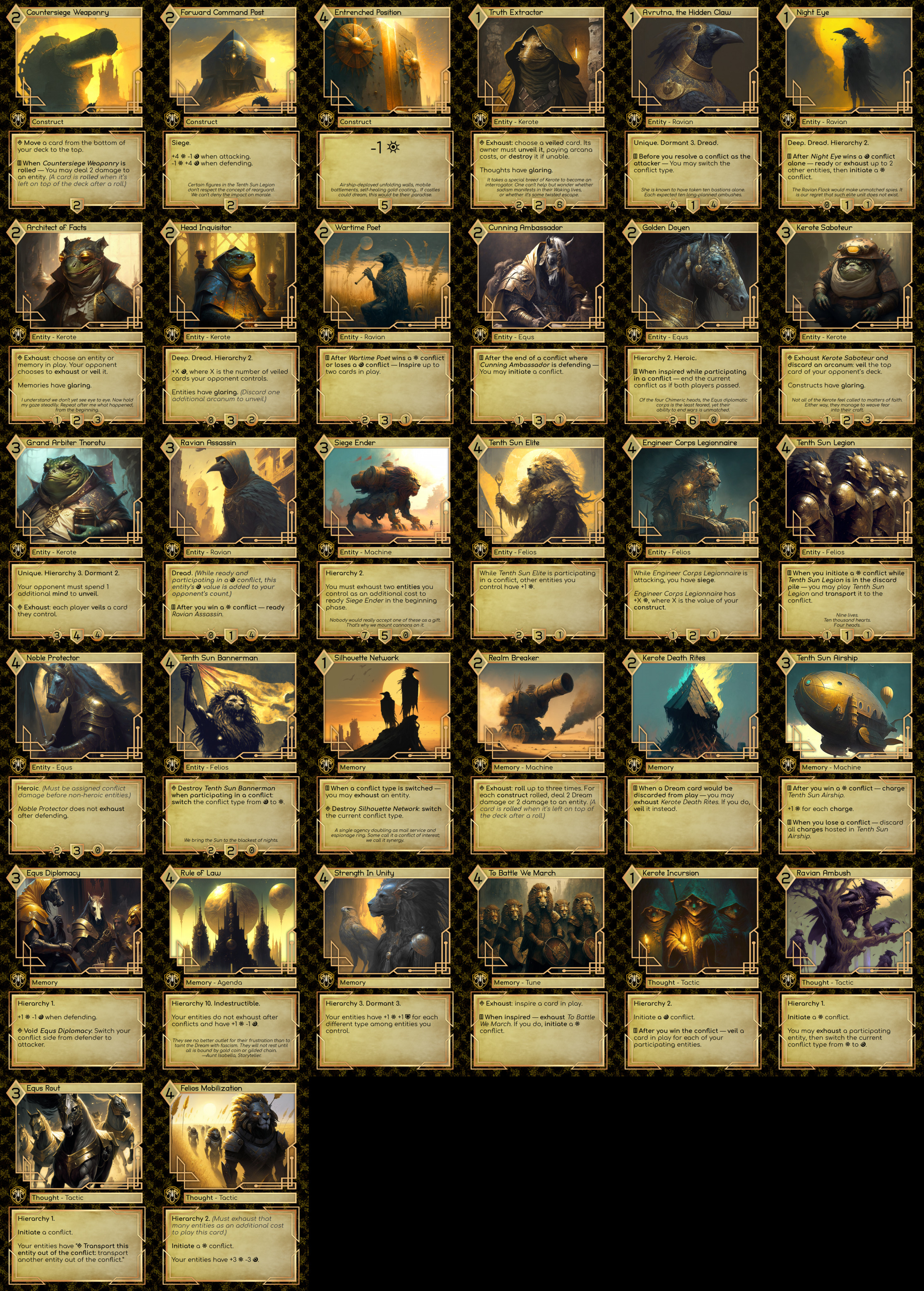
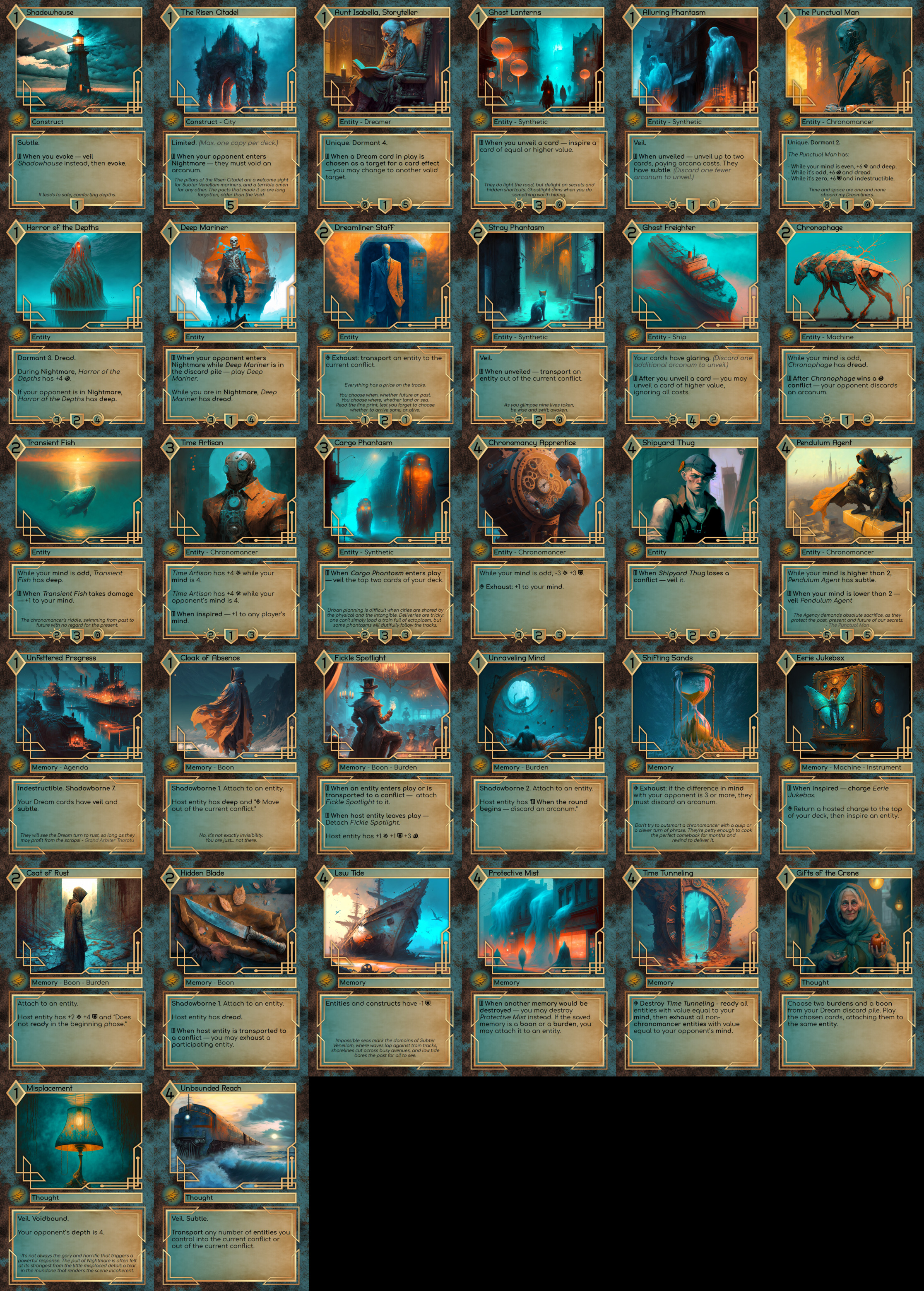

Bastions
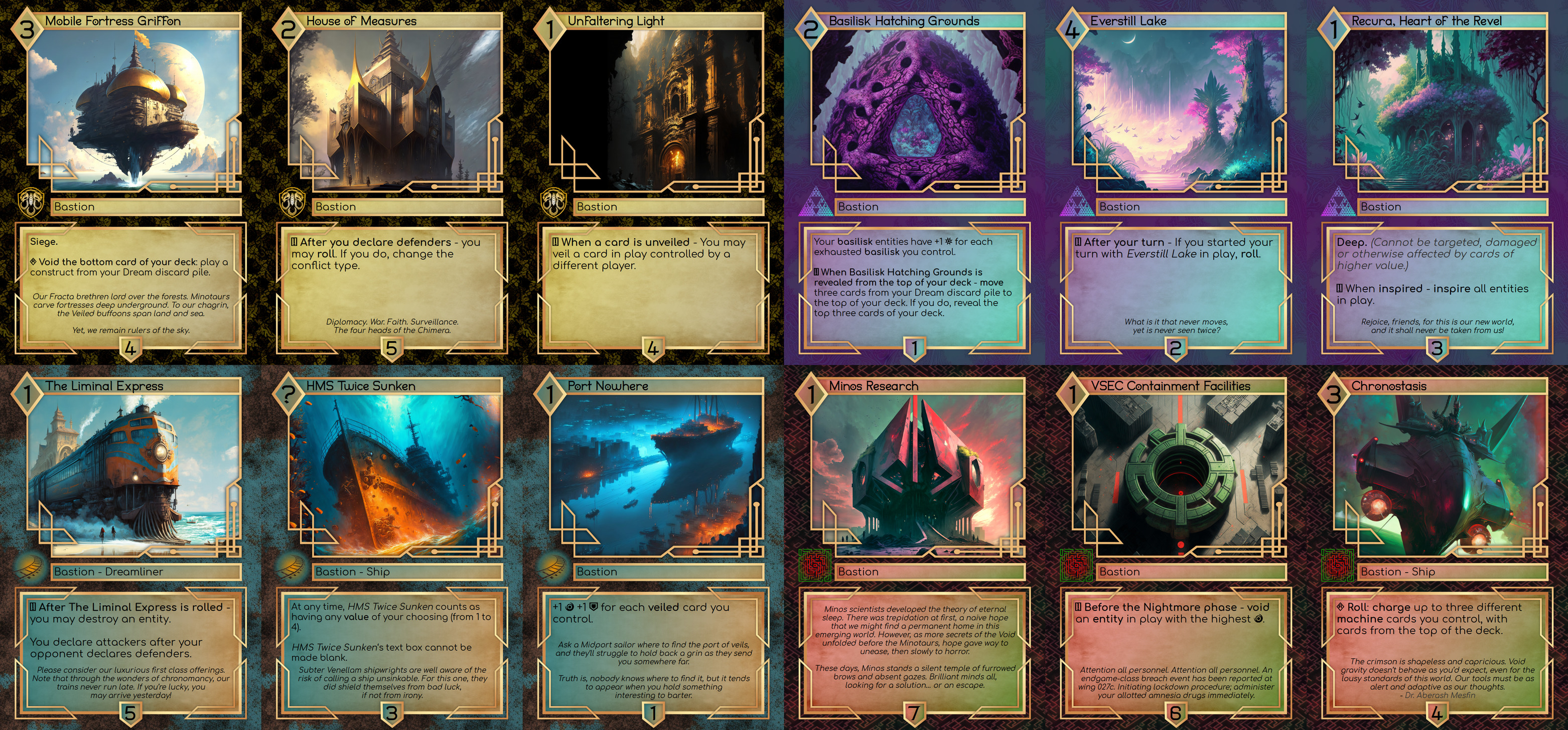

Arcana
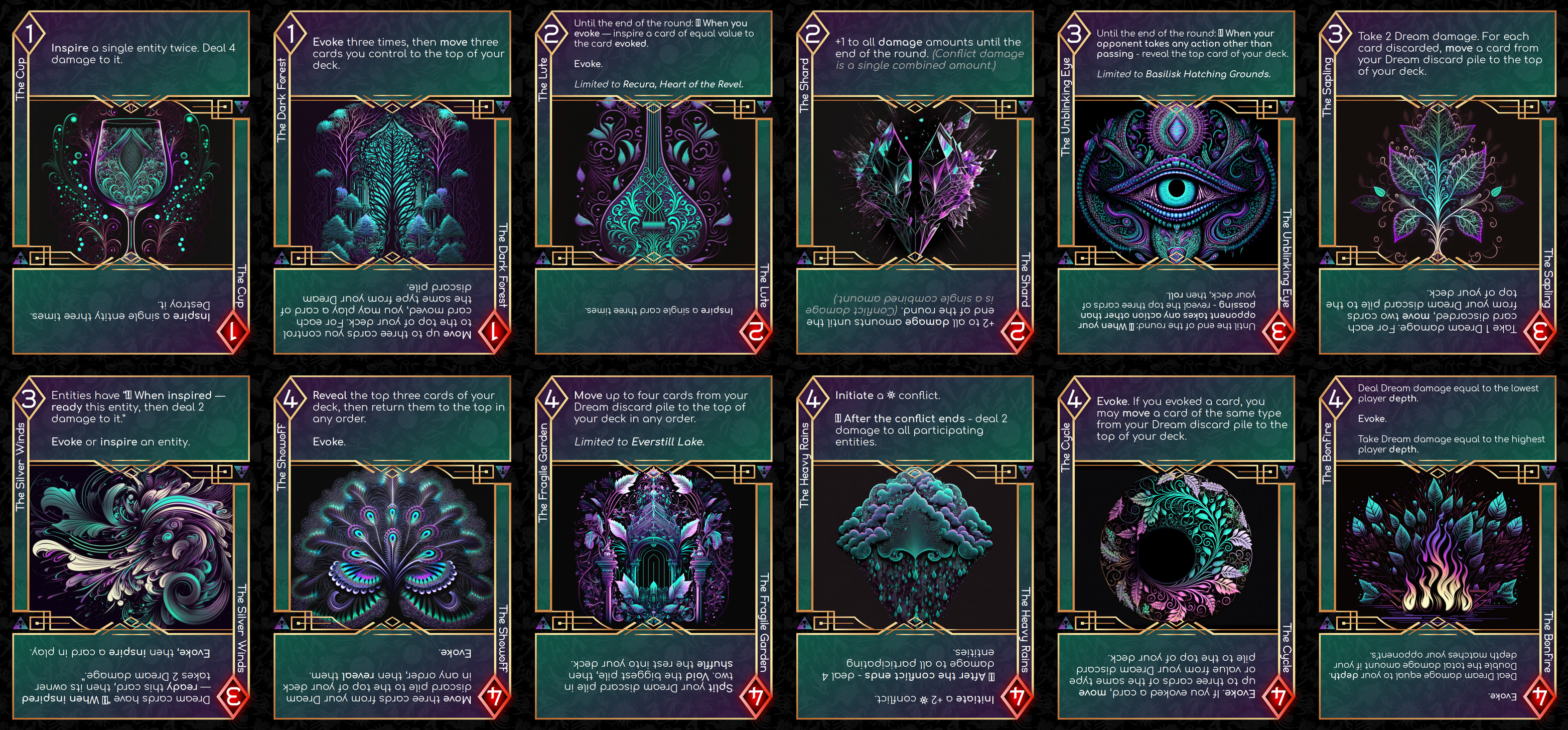
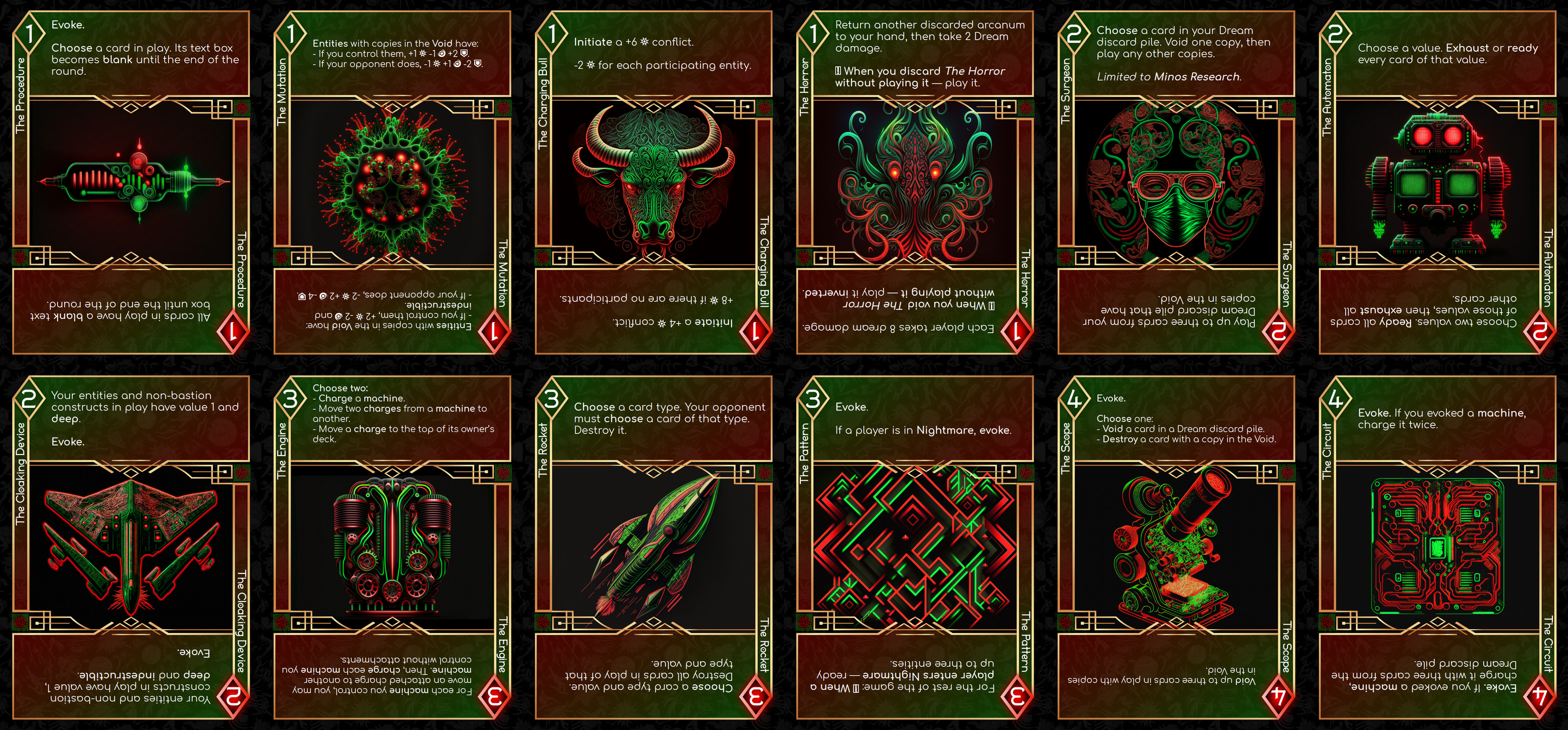
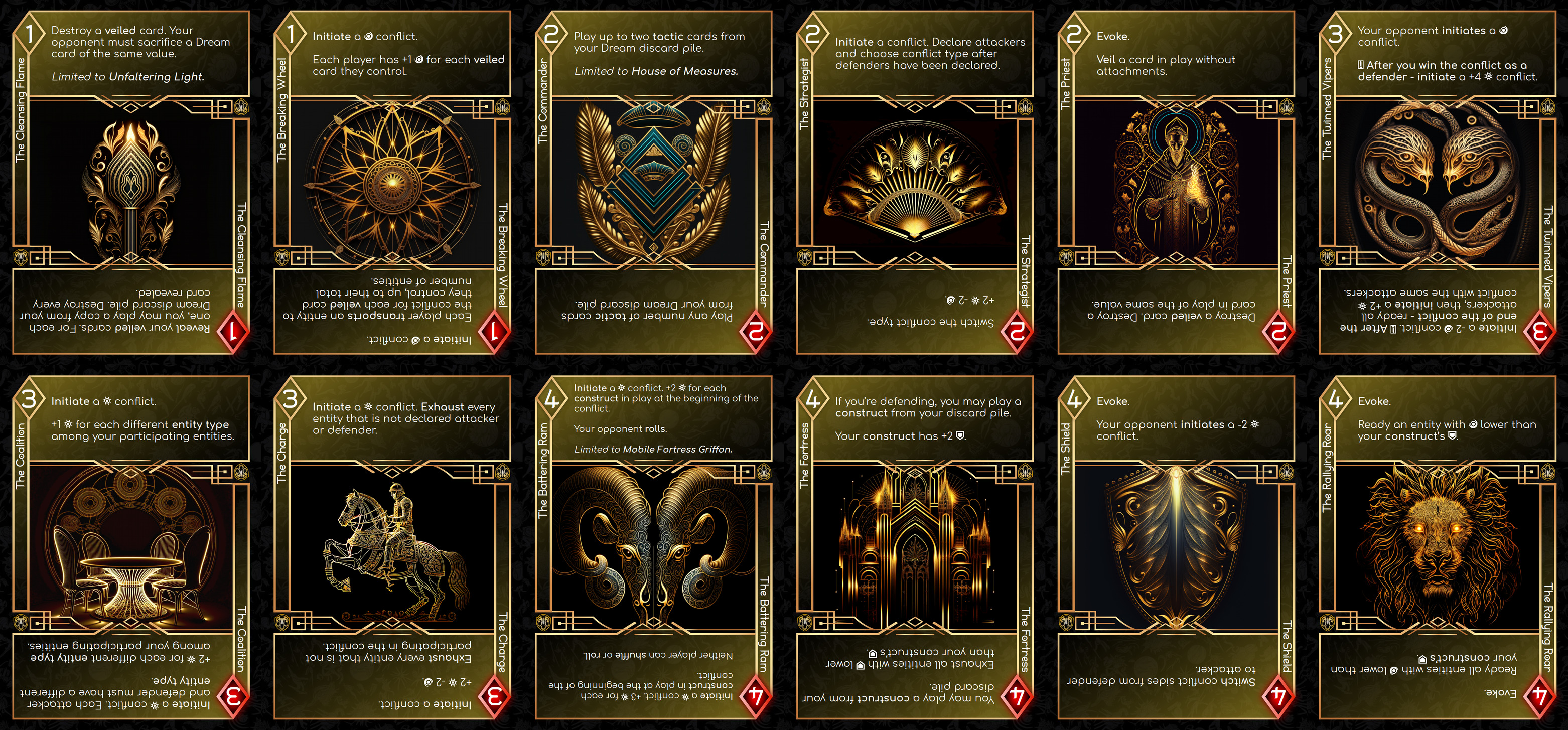
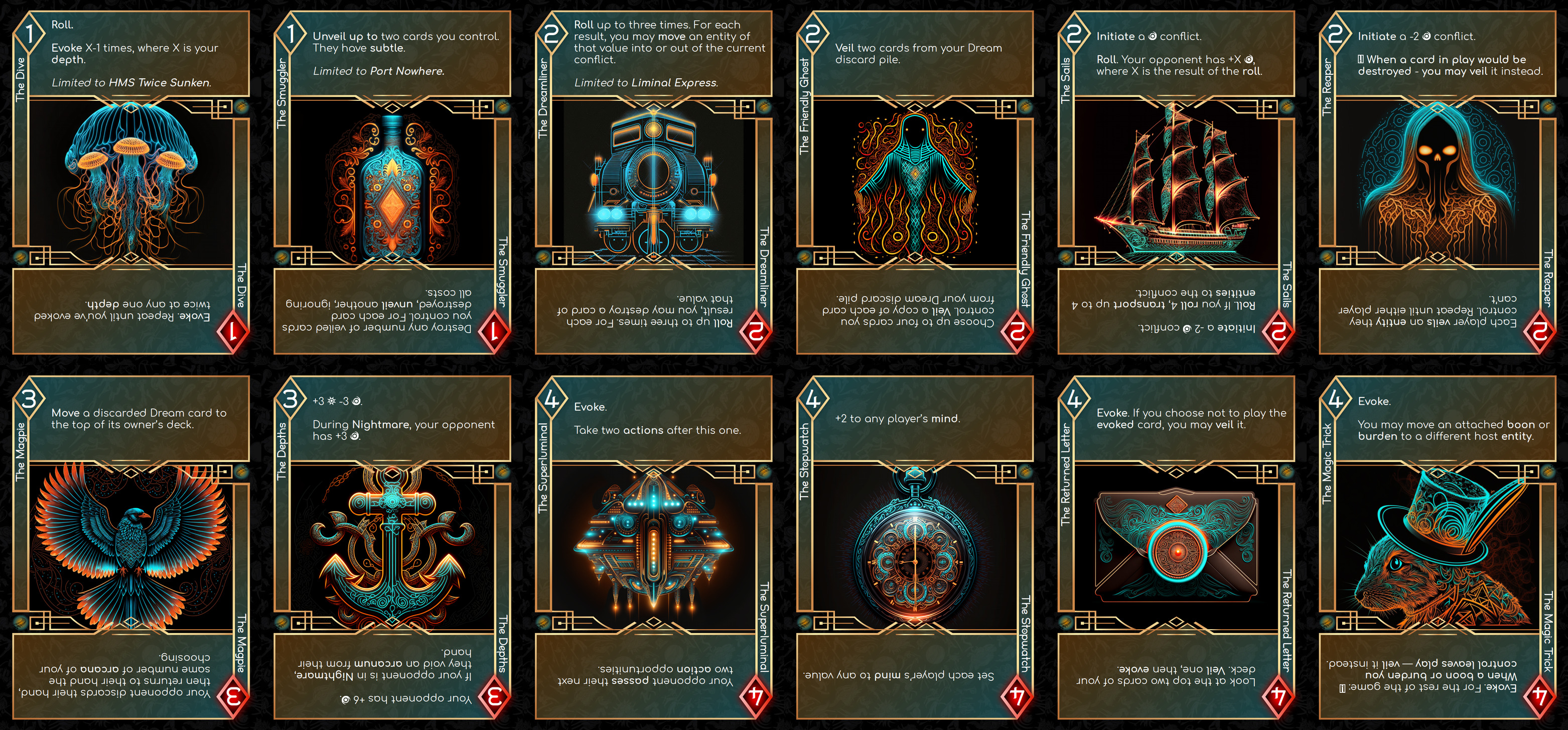
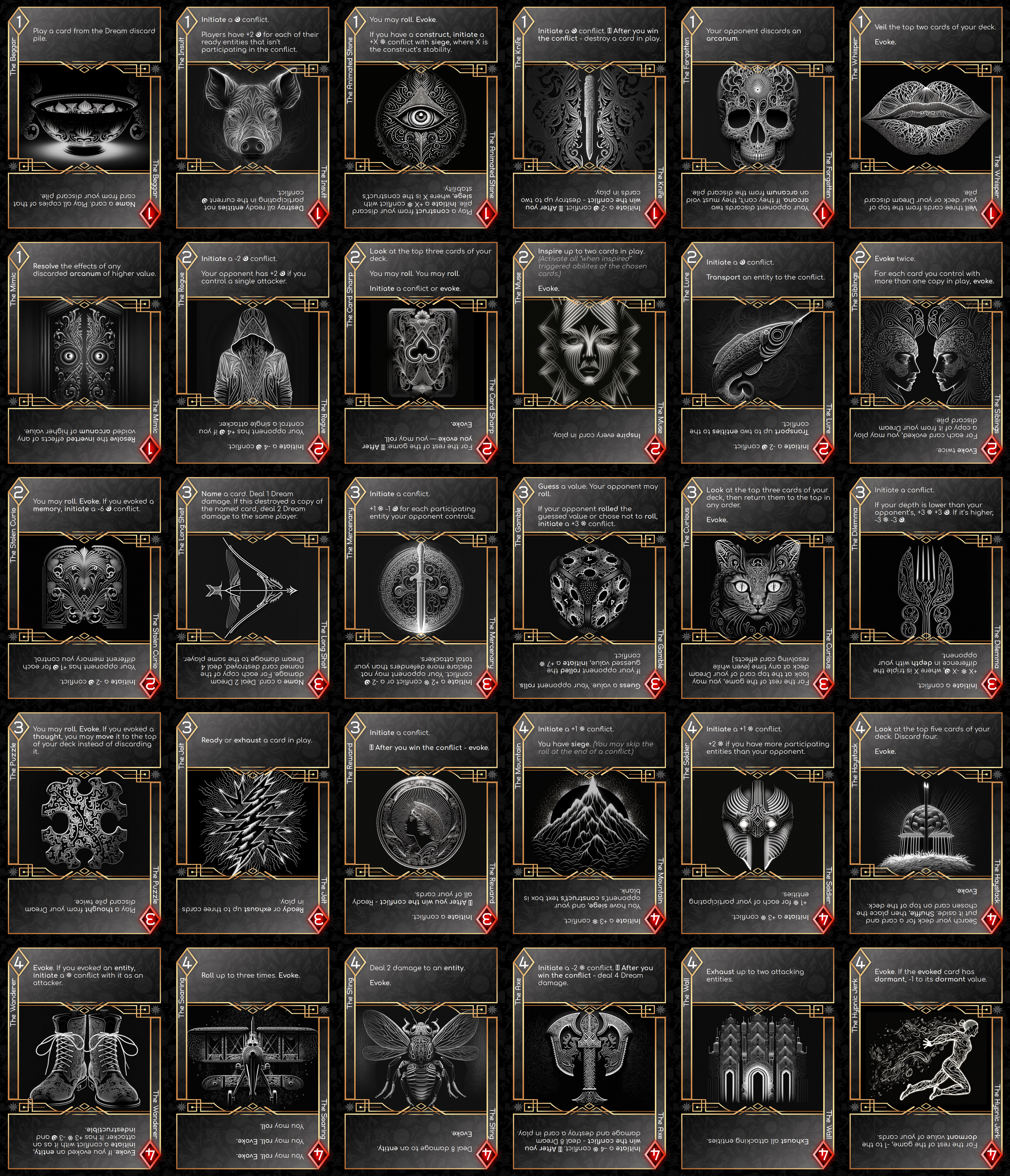
Mind Cards

